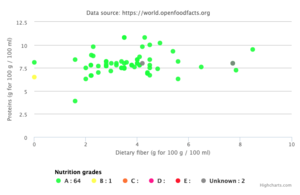Analysis of the rice category
A representative of the dutch food industry FNLI discussed Nutri-Score in relation with white and brown rices on the dutch TV journal om 9 april 2019). I will not repeat her conclusion.
This is a good reason to look at rices listed in the Open Food Facts database. This database consists of food products available in shops. The information related to these food products is entered by contributors and can be checked (and if necessary corrected) through associated product images. Each product is assigned to a category, which allows for easy comparison between products within the same category.
Thus the category rice consists of 1324 products in june 2019. The table below shows the average nutritional values. We assume that this worldwide sample is similar to the rices sold in the Netherlands, and thus any conclusion is also valid for the Netherlands.
If we use the average rice for a calculation of the average Nutri-Score: Energy contributes 4 points, Saturated fat 0 points, Sugars 0 points, Sodium 0 points, Fiber -2 points and Proteins - 4 points. We add these to get -2 points, which implies Nutri-Score A, i.e. green. This good value is due to the fiber and protein in rice.
Looking at the standard deviation, we see the largest deviation for proteins and fibre. Plotting 658 products on these two axes is shown below (why only 658 products):
Each dot represents a single product. The colours indicate the corresponding Nutri-Score. We see now some yellow and orange dots appear (the black can not be calculated, due to missing data on sugars). So not all rices are good. The graph makes it clear that the amount of fiber is the main variant in rice.
If we plot only the product category Brown Rices (67 products) below, we see only green dots
There is only one product below 1.6 g fiber (it is really a whole rice and has no fiber indicated on the package, I checked). So whole rice seems to indicate more than 1.6 g and on average 3.8 g. In the whole sample the average is 1.8 g.
Wondering whether manufacturers are driving consumers to fiber rich rices by adding labels such as "Rich in fibers", Could find only 2 (Spanish) products with such a label.
Instead of looking for a label, one can try to look only for organic products. The graph is shown below.
The green dots show products, which are labelled as organic. Clearly this indicator is not useful to find more fiber products.
Conclusion is that if a customer choses a whole rice, he will probably get a rice with more fiber, but there is no guarantee. And choosing another rice might provide him with a similar amount of fiber as well. One has to look at the nutritional values on the package to be sure. The name of the rice is no guarantee.
As a final remark: be careful doing these kind analyses on Open Food Facts. Check the outliers in order to see whether the data has been entered correctly and the product has been correctly categorised.



